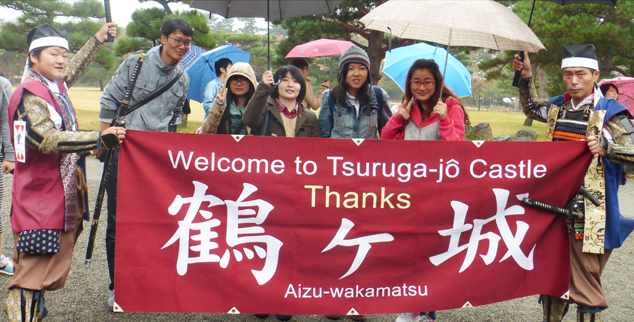
On Saturday, November 1, 2014, 28 university students from the People's Republic of China (*1) visited the UoA. The students came in order to understand and spread awareness of the situation in Fukushima.
Although there was some rain on the day of the event, the students visited Tsuruga-jo Castle (*2) with UoA students (14 Japanese and 13 international students). The students enjoyed the view from the top of the castle keep, taking pictures with the samurai armor-clad tourist guides, and browsing souvenirs at the gift shop. They also viewed the historic gardens and stone walls, listening attentively to the explanations provided by the tour guides and UoA students.
After moving to the UoA campus, the students enjoyed the famous Aizu treat "sauce katsudon" (*3) at the UoA cafeteria while talking with UoA students about the food cultures of China and Japan. After lunch, the students split into groups and went on tours of the campus, viewing the University's facilities before being greeted by Vice President Shigaku Tei (*4). Later, the students attended a workshop on foreign culture and international talk, exchanging opinions about the themes "what's important to me, and my dreams for the future" and "what we can do." The students also tried making mochi rice cakes with residents from the Nakagoya community (*5). The students paid close attention to a demonstration of the traditional method of making mochi (*6) with a large wooden mallet and mortar. Afterwards, when the students tried their hand at making mochi, they timidly pounded the rice at first, but eventually found a good rhythm. The students seemed to find the taste of the soft mochi they made themselves very interesting.
Having enjoyed the exchange of opinion and culture, everyone who came got along well. The UoA is looking to proactively create opportunities for these sorts of international exchanges (*7).
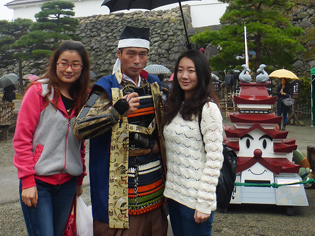
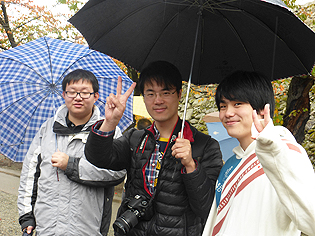
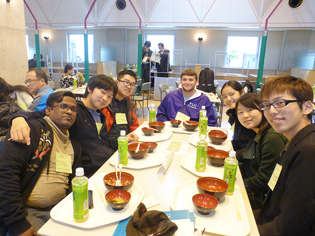
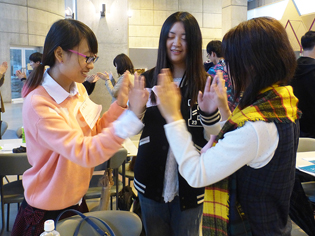
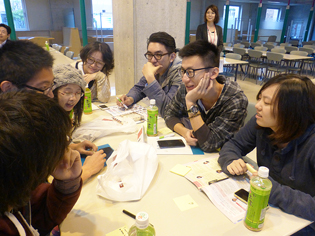
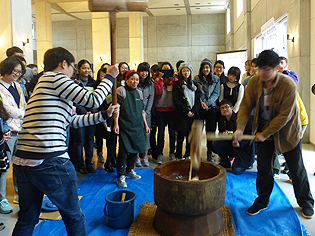
- *1 People's Republic of China (PRC):
- This time we had students from Chinese institutes including Tsinghua University, Hubei University, University of Shanghai for Science and Technology, Fudan University, and Zhejiang University. The UoA also has 11 faculty members and 19 students from the PRC (as of AY2014).
- *2 Tsuraga-jo Castle:
- A tourist attraction that symbolizes Aizu, Tsuruga-jo Castle (Wakamatsu Castle) is Japan's only castle with red roof tiles. Although the original castle was destroyed during the Boshin War (1868 to 1869), a replica of the castle keep was built in 1965.
- *3 Sauce katsudon:
- Sauce katsudon is a donburi dish that has been enjoyed in Aizu since the Taisho era (1912-1928). A deep-fried pork cutlet is coated in a thick, flavorful Worcestershire-style sauce and placed on a bed of shredded cabbage on top of a bowl (donburi) of steamed rice. The UoA Cafeteria belongs to the Traditional Aizu Sauce Katsudon Association.
- *5 Nakagoya Community:
- A community located in Minami Aizu. UoA students and international students hold exchanges with the residents of Nakagoya, participate in the community's Kogane Festival, help them run vegetable stands at the campus festival, and help with farm work.
Reference: UoA Students Participate in Kogane Matsuri , "Amur Adonis Festival"
- *6 Traditional mochi (rice cake) making:
- Although the Chinese also eat rice cake ("niangao") on New Years, Japanese rice cake ("mochi") originated instead from Chinese flatbread ("bing"), which both use the same character (餅). Japanese mochi is made by pounding steamed glutinous rice with a wooden mallet and mortar. Because of its stickiness, children and the elderly must be careful when eating mochi to avoid choking. The spread of store-bought mochi and electric mochi making machines has led to the traditional method of using a mallet and mortar becoming quite rare.
- *7 Opportunities for international exchange:
- For information on international exchanges with foreign exchange students, visit the Center for Strategy of International Programs site.


